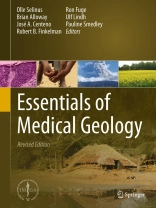Essentials of Medical Geology reviews the essential concepts and practical tools required to tackle environmental and public health problems. It is organized into four main sections. The first section deals with the fundamentals of environmental biology, the natural and anthropogenic sources of health elements that impact health and illustrate key biogeochemical transformations. The second section looks at the geological processes influencing human exposure to specific elements, such as radon, arsenic, fluorine, selenium and iodine. The third section presents the concepts and techniques of pathology, toxicology and epidemiology that underpin investigations into the human health effects of exposure to naturally occurring elements. The last section provides a toolbox of analytical approaches to environmental research and medical geology investigations.
Essentials of Medical Geology was first published in 2005 and has since won three prestigious rewards. The book has been recognized as a key book in both medical and geology fields and is widely used as textbook and reference book in these fields.
For this revised edition, editors and authors have updated the content that evolved a lot during 2005 and added two new chapters, on public health, and agriculture and health. This updated volume can now continue to be used as a textbook and reference book for all who are interested in this important topic and its impacts the health and wellbeing of many millions of people all over the world.
· Addresses key topics at the intersection of environmental science and human health
· Developed by 60 international experts from 20 countries and edited by professionals from the International Medical Geology Association (IMGA)
· Written in non-technical language for a broad spectrum of readers, ranging from students and professional researchers to policymakers and the general public
· Includescolor illustrations throughout, references for further investigation and other aids to the reader
İçerik tablosu
Medical Geology: Perspectives and Prospects.-
Public Health and Geological Processes: and Overview of a Fundamental Relationship.-
Natural Distribution and Abundance of Elements.-
Anthropogenic Sources.-
Uptake of Elements from a Chemical Point of View.-
Uptake of Elements from a Biological Point of View.-
Biological Functions of the Elements.-
Geological Impacts on Nutrition.-
Biological Responses of Elements.-
Volcanic Emissions and Health.-
Radon in Air and Water.-
Arsenic in groundwater and the environment.-
Fluoride in natural waters.-
Water Hardness and Health Effects.-
Bioavailability of Elements in Soil.-
Selenium Deficiency and Toxicity in the Environment.-
Soils and Iodine Deficiency.-
Geophagy and the Involuntary Ingestion of Soil.-
Natural Aerosolic Mineral Dusts and Human Health.-
The Ecology of Soil-Borne Human Pathogens.-
Animalsand Medical Geology.-
The impact of micronutrient deficiencies in agricultural soils and crops on the nutritional health of humans.-
Environmental Epidemiology.-
Environmental Medicine.-
Environmental Pathology.-
Toxicology.-
Speciation of Trace Elements.-
GIS in Human Health Studies.-
Investigating Vector-Borne and Zoonotic Diseases with Remote Sensing and GIS.-
Mineralogy of Bone.-
Inorganic and Organic Geochemistry Techniques.-
Histochemical and Microprobe Analysis in Medical Geology.-
Chapter Modeling Groundwater Flow and Quality.-
Appendix A International Reference Values.-
Appendix B: Web Links.-
Appendix C: Glossary.-
Index.












